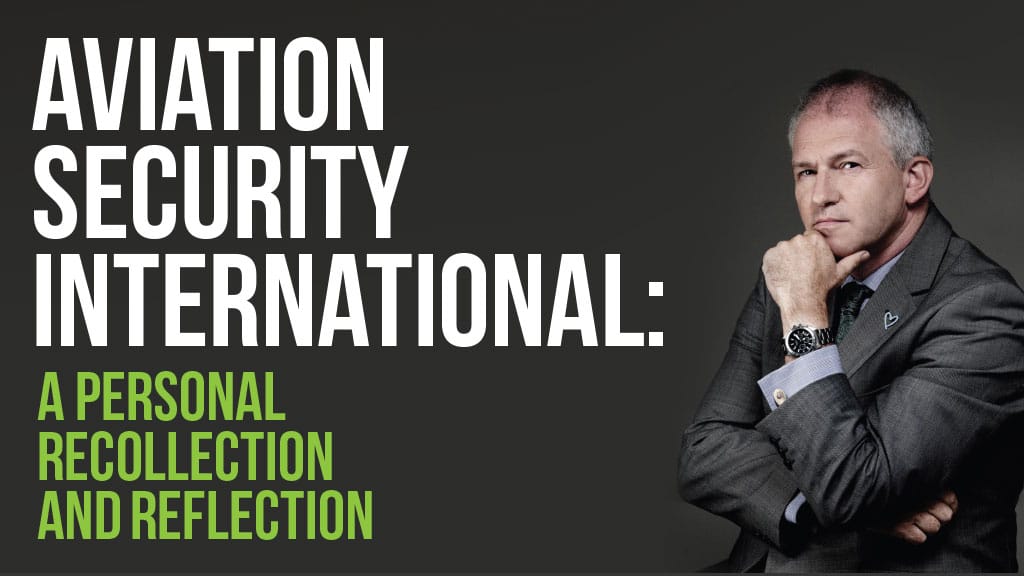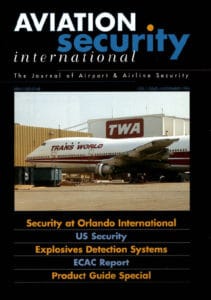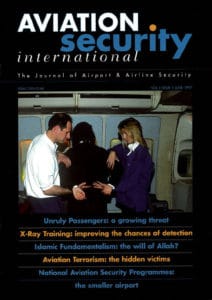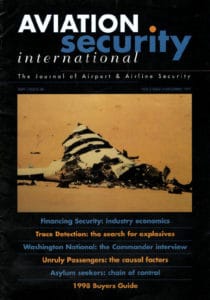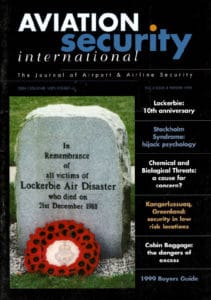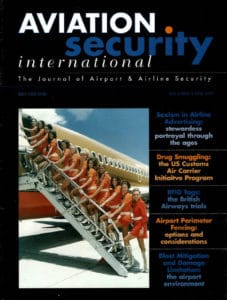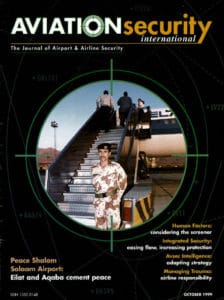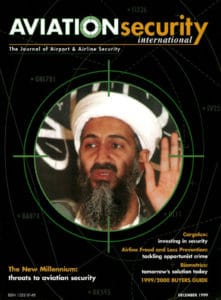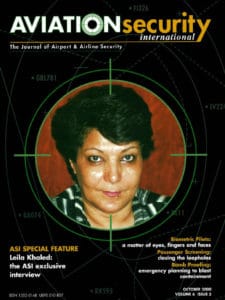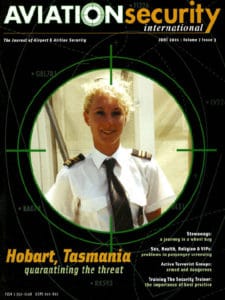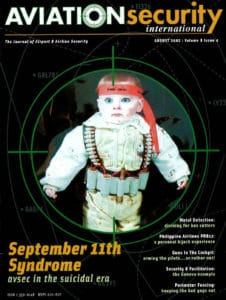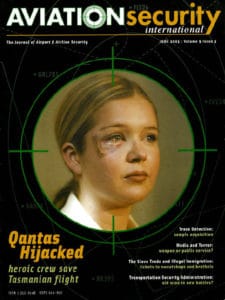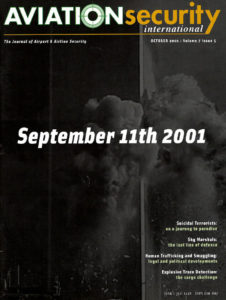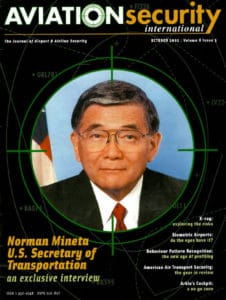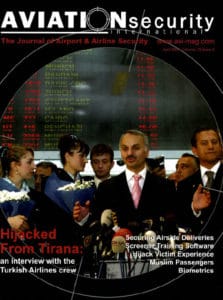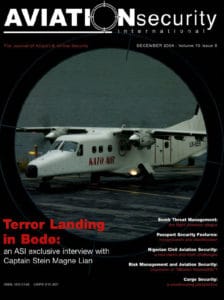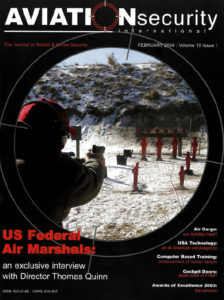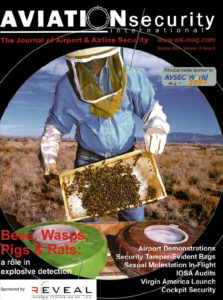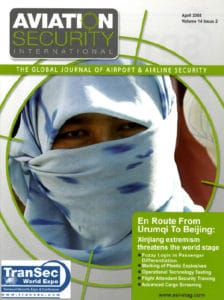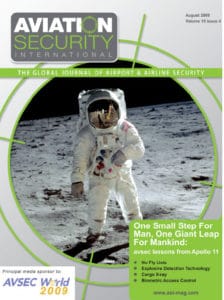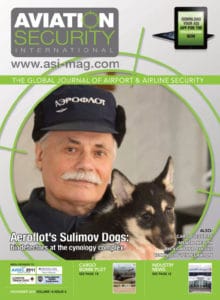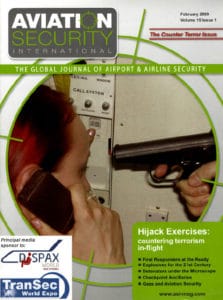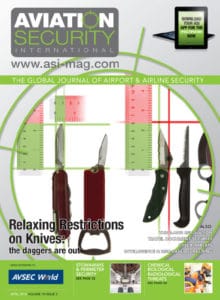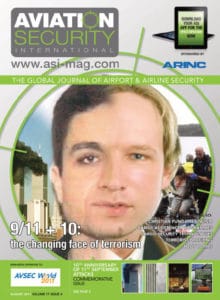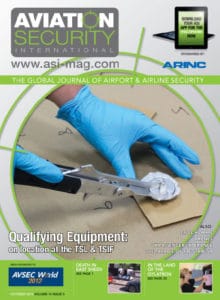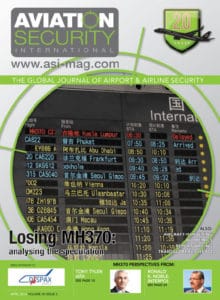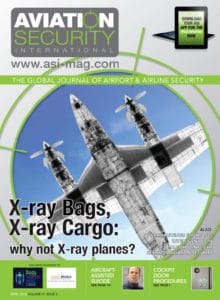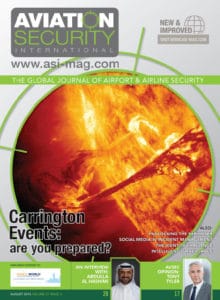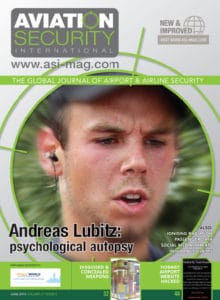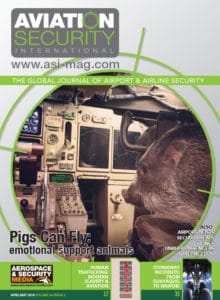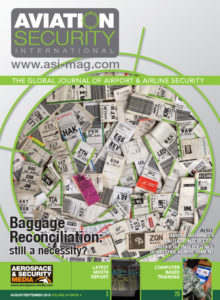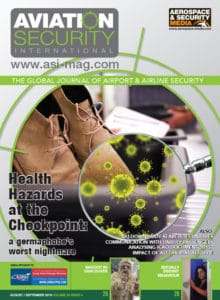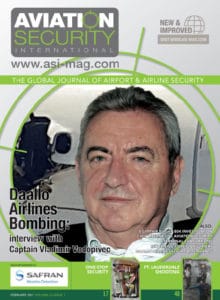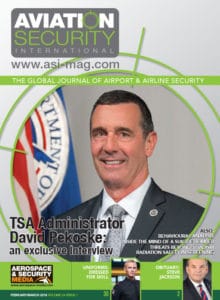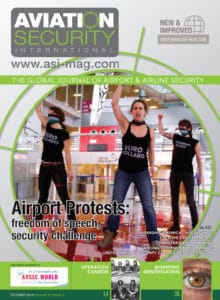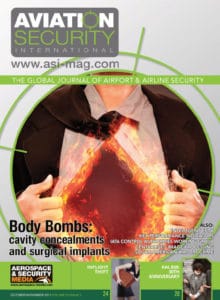This issue is the final time Aviation Security International goes to press. For its editor-in-chief, it has, for almost quarter of a century, been a labour of love. Philip Baum has served as its editor and, for a number of years, its owner. He has personally penned 138 lead editorials, conducted 11 exclusive interviews, and written 56 feature articles himself, whilst editing the contributions of hundreds of other authors. As this title enters the annals of aviation security history, Philip writes one final article in which he guides us through the journal’s development, highlights some of his own messages delivered – signposted by many of the industry’s key incidents – and shares, in a personal way, his own reflections on his time at the helm.
The flight departed in November 1993. That date marked the inaugural issue of Aviation Security International (ASI).
I well recall the initial discussions regarding the launch of what was to become the global journal of airport and airline security. At the time I was working for TWA’s security subsidiary, International Aviation Security, and editing the in-company newsletter Catch-22. I was summoned by my directors to meet Brenda Jackson and Paul White to discuss our future collaboration on their forthcoming venture. Little did I know then that the publication they can be credited for launching was to become part and parcel of my own life.
Halldale Publishing & Media acquired the publication from Brenda and Paul and re-launched the title in October 1995. Editor-in-chief: Trevor Nash.
The Early Years
My own active involvement with ASI was borne out of tragedy. On 17 July 1996, TWA flight 800 exploded shortly after its departure from New York en route to Paris; there was considerable speculation at the time that the cause of the disaster was a terrorist bomb. Having become an independent consultant that February, and given that I had previously worked for TWA, it was hardly surprising that Trevor Nash asked me to write my own analysis of the disaster. The feature, entitled ‘TWAergate!’, appeared in the November 1996 issue. Reading it now, I can see my views have changed little and many of the issues facing the industry today were issues then.
In December 1996, IATA’s AVSEC World was held in Sydney. For some bizarre reason, Trevor Nash didn’t want to go. As a fresh consultant seeking a platform, I leapt at the opportunity to accept an all-expenses paid trip to Australia in return for writing a review of the event. Also in attendance was ASI’s publisher, Andy Smith, who took the opportunity to find out if I would be interested in taking over the reins as the journal’s editor-in-chief. I was.
The June 1997 issue was my first at the helm and also marked the introduction of the editorial advisory board; Geoffrey Askew and Norman Shanks were part of that illustrious group and have remained in role ever since. My first lead editorial highlighted my desire that ASI become a training tool and provide a medium for effective communication. The single pull-quote illustrated this: “Good security, it is said, depends to a significant extent upon good communication.”

By September 1997 I was setting out my stall and championing issues, which remain unresolved by the industry. In this case it was about governmental delegation of responsibility for security to the airports and airlines. “Few would argue that responsibility for customs or immigration matters should be delegated to a private company. And the very concept of neighbourhood security being taken out of the hands of the police or the military ceasing to have control for national security is abhorrent. Yet when it comes to the safety of passengers’ lives aboard aircraft many governments have abdicated their responsibility.” Seemingly it only took me three months to write my first article advocating passenger profiling – I’m actually surprised it wasn’t in my first issue!
Another line I have been ever-keen to promulgate has been that of the need for proactive security. In my Summer 1998 editorial ‘Tony Benn or The Starship Enterprise?’, I referenced Anthony Wedgwood Benn, a maverick British Labour politician, who had once said that, “in developing our industrial strategy for the period ahead, we have the benefit of much experience. Almost everything has been tried at least once.” My sense was that we were, mistakenly, viewing our approach to aviation security in a Bennite light rather than, in order to remain one step ahead of the terrorist who would try innovative approaches to circumvent security, adopting a Star Trek mentality and “boldly go where no man has gone before.”
As I write this review, the tragic downing of Pan Am flight 103 in 1988 remains headline news. The Winter 1998 issue of ASI was dedicated to commemorating the lives stolen a decade earlier, yet it also demonstrated the wide range of avsec-related topics, which ASI explores. Features included, ‘Stockholm Syndrome et al: hijack psychology’; ‘The Enemy Above: the case of the case too many’ (looking at the security challenges associated with the carriage of excess hand baggage); ‘Kangerlussuaq: avsec the Greenlandic way’; a review of the ICAO-ECAC European Aviation Security Training Institute; and, addressing a topic I still maintain has been woefully ignored by the aviation security industry, ‘Chemical and Biological Weapons: a cause for concern?’ The latter was written by Gwyn Topham, then a student at the University of Bristol, but now The Guardian’s, and Observer’s, transport correspondent.
In February 1999, my lead editorial ‘Quashing Convictions’ took aim at the British judiciary and the exoneration of the six Iraqis who had hijacked a Sudan Airways flight to London back in 1996. Lord Justice Rose had argued that, “If Anne Frank had stolen a car to escape from Amsterdam and had been charged with theft, the tenets of English law would not have denied her the defence of duress of circumstances on the grounds that she should have awaited the Gestapo’s knock on the door.” I had no qualms about the decision to grant the hijackers asylum, rather than returning them to face likely execution, yet legitimising hijacking seemed then, and now, a step too far.
The first formal interview I carried out was with the then spokesperson on aviation security for the Air Transport Association of America (ATA). This was 1999 and the time of the controversial Hatch Amendment, which sought, in order to create a level playing field, to require all airlines flying to the USA to apply identical security measures at the last airport of departure to those imposed by the FAA on US airlines. ATA supported the initiative decried by Europeans as an infringement of their sovereignty. But, perhaps more interesting was the response to my questions about security measures being applied to domestic flights in the US. “We feel the current measures that we are implementing with the FAA are sufficient”, she said before going on to say, when pushed, that “You have to remember that we board 1.5 million passengers per day on our airplanes, with 20,000 daily departures. We need a system that will facilitate our schedules in order to meet the needs of our customers”. She argued that, “It is unfair to compare our domestic system with that of any other country. It is our main means of inter-modal transportation”. This was two years before 9/11.
The Green Light Years
By June 1999 Green Light had purchased ASI from Halldale Publishing & Media. I had become publisher and editor. ‘Air Watch’, whilst a regular feature of the journal, rarely took up more than a page. For historical record, it’s worth recording that the graphic artist at the time was Nikki Francis of JB Graphics.
It did not take us long to receive our first letter of complaint. On the front cover of our December 1999 issue, we featured the then relatively unheard of, Osama bin Laden alongside the title ‘The New Millennium: threats to aviation security’.
I can’t recall the exact content of the letter, but I believe it was from a disgruntled reader who implied that we were giving the enemy publicity. For us, it was about communicating the nature of the threat to the industry. In Prof. Paul Wilkinson’s article on the subject, he wrote, “A key lesson of Lockerbie, which sadly has not been acted upon in many countries, is that we should never allow our security technology and policies to be overtaken by the tactics and methods of aviation terrorists.” He continued, “If aviation policymakers are doing their job properly in the new millennium, we should see a constant effort to adapt and upgrade standards of security to meet new or emerging threats.”
Wilkinson did issue the caveat that, “in adapting to meet the new generation of terrorist groups, such as those in which Osama bin Laden and Ramzi Yousef have been involved, we must not neglect to improve our effectiveness in dealing with the more ‘traditional’ threats such as hijacking”. The article was, after all, written in the aftermath of the 12 April 1999 hijacking of an Avianca flight by the ELN. The year, and indeed the last millennium, was to end with the hijacking of Indian Airlines flight IC814 – a very traditional, yet callous and drawn-out hijacking that concluded on 31 December 1999.
In June 2000 we launched the inaugural ‘Aviation Security International Industry Awards’, co-sponsored by IATA and ACI. They were to have been presented at AVSEC World in Bahrain, although this was moved at the 11th hour to Miami following the crash of Gulf Air flight 072 that August. The lifetime award for service to the aviation security community was given to Brian Wall, IATA’s director of security services.

One of the most memorable moments of my time as editor of ASI was certainly when, in September 2000, and marking the 30th anniversary of the Dawson’s Field hijackings, I flew to Amman, Jordan, to interview Leila Khaled. Khaled had been one of the PFLP’s hijackers on board the El Al flight. Her mission failed and her fellow hijacker had been killed. My lead editorial of the October 2000 issue, ‘Speaking with the Enemy’, highlighted the dilemma I had faced as to whether it was right to afford her column inches. I know that many readers disagreed, but I rationalised it by being clear that this interview was for the industry and in the interests of the industry; we have to understand the mindset of those who we are up against. There were some angry letters in my inbox, but the vast majority really appreciated the perspective the interview offered.

Far harder than deciding whether to conduct the interview at all was the angst I felt waiting for Khaled in the lobby of the SAS Radisson and the realisation that I was going to have to greet her amicably. As my lead editorial concluded, “I shook a hand that has held grenades on board an El Al flight and placed an explosive charge that resulted in the destruction of a TWA airliner.”
Traditional hijacks continued in 2001. In our April issue we paid tribute to Yulia Fomina, the flight attendant killed during a commando raid to end the hijacking of a Vnukovo Airlines flight in Moscow. In the same issue, I reflected on my interview with the crew of Indian Airlines flight IC814 eleven months after the attack had taken place; the cabin crew claimed that I was the first person to have formally asked them any questions about the week-long ordeal. Only the technical crew had been spoken to by those investigating the atrocity.
It was a presentation given by Luppo Prins, of the Tasmania Police, back at AVSEC World 1996 in Sydney, that initiated the lead editorial, ‘Tasmanian Quarantine’, in June 2001. Prins had spoken about the Port Arthur massacre in which Martin Bryant had killed 35 people at the historic site on 28 April 1996. I recalled how many delegates had questioned the inclusion of the presentation in the programme, some viewing it as being sensational yet of little value to the aviation security community. I considered that mindset to be myopic and felt that the industry needed, especially for those who are not at the crosshairs of terrorist activity, to appreciate that we are all a target. As I wrote, “I have heard all too frequently from representatives of airlines and airports, especially the smaller ones, around the world”, that, “Hijackings don’t affect us”, or “We’re not really a target”, or “Terrorists don’t target aviation any more.” An issue, prevalent to this day, is that far too many engaged in aviation security still regard it as a purely counterterrorism exercise. I maintain now, as then, that, “Security is not the same as counterterrorism. Security means the protection of lives and assets from all manner of threats, be they terrorist, criminal, natural, or the actions, as in the case of Martin Bryant, of a psychologically disturbed individual.”
In that same June 2001 issue, Prof. Paul Wilkinson wrote for us again. “The fact that bin Laden has been implicated, at least indirectly, in the worst ever planned aviation terrorism atrocity uncovered [Bojinka Plot] means that his organisation should be monitored with extreme diligence, not only by the US but by all law-abiding states.”
My own editorial in August 2001 followed this theme when discussing the ICAO Mechanism and the pros/cons of supporting poorer states. Given that, “When the likes of bin Laden target embassies in Kenya and Tanzania, they are attacking the weakest link”, I queried the fact that security is often ‘better’ at departure airports in the developed world than some of the developing world’s airports serving tourist destinations. “So, while the affluent in the West go off on their summer vacations to far-flung destinations, they can marvel at their pristine terminals with all the latest gadgetry. As for the return journey… well, I guess we’ve covered half the journey, so I suppose we must have reduced the risk.”
And then the world changed…
11th September 2001
Those of us old enough to recall the events – and increasingly I find myself running courses for people who don’t – know where they were when they first heard the news. I was sitting at my desk – exactly where I am seated now – when Sky News called me to request an interview. What they actually wanted to discuss was the headline story of that day’s Mirror newspaper which was leading with ‘Lockerbie: the lost evidence’ and claimed that, in a world exclusive, their “documents prove that bomb could have been planted at Heathrow after break-in”. I declined the interview on the basis that, 13 years after the bombing, I had no intention of stoking the story any further. It was during that call that the first plane crashed into the World Trade Center. Within minutes I was on my way to Sky television centre…
Four days later, just as soon as flights could resume, I found myself on an almost empty British Airways flight to New York to join the media teams at Ground Zero. “The grotesque remnants of the World Trade Center lay before me. The only sound was of trucks and cutting equipment being utilised by rescue workers. No one spoke. The ruins still smouldered.”
The October 2001 issue of ASI reflected the unique nature of this cataclysmic terrorist outrage; we dispensed with our traditional cover and ran an image of a collapsing tower at the WTC. The issue reflected the gravity of the event. Joe Paresi provided a personal account of his witnessing the collapse of those towers from his uptown offices in New York; David Lord, having moved on from the Department of Transport to ICTS, wrote a feature entitled ‘Black September: what next?’; Billie H. Vincent, the former head of security at the FAA, set out his proposed agenda for change to aviation security in America; Raine Marcus provided a chilling article, ‘Suicidal Terrorists: on a journey to paradise’; we included extracts from al-Qaeda’s training manual (released by the FBI, and carried by Mohamed Atta in his luggage); Mena Bacharach and Amos Golan both wrote perspectives on sky marshal deployment; and Alex Brummer, who is the city editor of the Daily Mail, penned ‘Counting the Cost: the insurance world’s biggest challenge’.

The Noughties
Somehow, I found a way of weaving the football team I support into my lead editorial in December 2001. ‘Ipswich Town were one goal down against Helsingborg, playing away and facing an early exit from European soccer – for this season at least. “There are lots of shots on target”, said the match commentator “yet no team co-ordination. Unless they start playing as a team, the game is lost”’. I argued that this resonated with our approach to aviation security, postulating that, “we’ve got loads of solutions being promulgated but little in the way of a coordinated effort.” It was a good news story, concluding with the words “There is our lesson: play as a team… and in case you were wondering, Helsingborg 1, Ipswich Town 3.”
Ipswich Town has since been relegated to the third tier of English football.
The recipients of our 2001 awards for lifetime service to the aviation community were Allen Tonai Agor of the FAA and Rafi Ron of the Israel Airports Authority. The individuals award for outstanding contribution to aviation security that year went, posthumously, to Todd Beamer, Mark Bingham, and Thomas Glick for their efforts to fight back against the terrorists on board United Airlines flight 93 on 9/11.
Over the years we have reported on some exciting new technologies designed to better secure the industry. Remember Ray Israel’s EDS Discovery (a.k.a. shake ‘n bake) cargo screening solution? Ranger’s Body Orifice Security Scanner (B.O.S.S.)? Quantum Magnetics’ i-Portal 100? Scentinel’s boarding pass analyser? We always tried to highlight some of the more innovative solutions under development and these appeared with increasing regularity in the aftermath of 9/11. In that vein, and still offering huge potential to revolutionise checkpoint screening operations, Qylur’s Qylatron even resulted in our US-based technology review (from October 2012) using its name in the title: ‘Made in the USA: In the Land of the Qylatron’. If there were an award for most creatively named product, there’s no questioning the winner. “Qylur takes its name from the Condylura Cristata – star-nosed mole – a functionally blind animal that uses its fleshy snout, surrounded by eleven pairs of pink appendages emvbedded with 25,000 sensory receptors, to detect and hunt its prey.”


Yet my penchant for the human-interest stories from aviation security history resulted in another ASI scoop in April 2002 when I was fortunate enough to travel to Belgrade and interview Vesna Vulovic, the flight attendant who fell 33,000 feet to earth after a bomb detonated on board the JAT flight she was operating on 26 January 1972. “Nobody knows how Vesna survived the accident. Some have said it was due to the fuselage hitting the side of a hill at an angle”, yet albeit crippled for life, she was alive (at the time) and able to provide readers with a tale of hope.

Another flight attendant, Michal Eder, was able to provide her story of survival in our June 2002 issue. Eder was one of the flight attendants on board El Al Israel Airlines flight LY219 – the flight which Leila Khaled had attempted to hijack back in 1970.

Courting controversy again, ASI’s August 2002 cover image was of a picture released by the Israel Defence Forces, which showed a Palestinian baby dressed like a suicide bomber. Conversely, my lead editorial in that issue, ‘September 11th Syndrome’, actually set out to challenge the perception of the enemy as always being Muslim. I defined the syndrome to be “the industry’s ability to succumb to the mistaken belief that all future acts perpetrated against civil aviation will be carried out by suicidal Middle-Eastern terrorists armed with box cutters.”
We marked the first anniversary of 9/11 (in our October 2002 issue) with an exclusive interview I conducted with US Secretary of Transportation Norman Y. Mineta. Our lifetime service award for 2002 went to Rear Admiral (Retired) Cathal ‘Irish’ Flynn of the FAA.
Readers will be all-too familiar with my concern about the over-reliance on technology in the screening process. My February 2003 lead was even titled ‘100% HBS: 99% Charade’. It’s not that I doubt the capability of the technologies, rather that those capabilities are so limited in range and are nearly always a reactive response to an event that has happened rather than a proactive measure to guard against future innovation in terrorist or criminal activity.
In May 2003, there was an attempted hijack aboard Qantas flight 1737 en route from Melbourne to Launceston. The perpetrator, David Mark Robinson, had attempted to seize the aircraft using wooden stakes he had infiltrated on board in the knowledge that they would not be detected in his jacket lining by an archway metal detector. He intended to gain control of the aircraft and crash it into a remote part of Tasmania. The event was significant to me for two reasons: firstly, I was in Australia at the time and had even given a presentation on hijacking that day to delegates convening at a conference at a Melbourne hotel; but most importantly, secondly, because the story perfectly exemplified all my avsec mantras!
The threat to aviation security is not only on routes deemed to be ‘high risk’ – this incident was on a flight to Launceston. The threat is not only to international aviation – this was a domestic routing. Suicidal hijackings do not need to be perpetrated by Islamists – mental ill health, as was the case with Robinson, exists in all countries. Technology has its limitations – metal detectors can’t detect wooden weapons, nor ceramic, glass, or carbon ones and nor can they detect explosives. The aircrew, and especially flight attendants, are of fundamental importance to the aviation security system – as demonstrated by the heroic actions of Greg Khan and his team in the cabin.

I regard the attempted hijacking of QF1737 as THE case study for the 21st century.
The June 2003 issue was significant for another reason. It marked the transfer of the ownership of the title from Green Light to Simply Events, co-owned by Adrian Broadbent and Peter Jones who had jointly launched AirPORT Security Expo six months earlier. I wrote that ASI had “become my fourth child, one that I have lovingly reared. Whilst it obviously cannot compete with my three daughters, ASI has certainly become an important part of my life”.

The Simply Years
By now ‘Air Watch’ was a double-page spread! After our 2003 lifetime service award to Takis Tassopoulos (Athens International Airport & ICAO) and our outstanding individual awards to Greg Khan (Qantas) and Simon Hui (AVSECO), the ASI awards of excellence ceased since ACI and IATA, who were now jointly running AVSEC World, had decided to offer their own awards. And, we continued, using the words of AVSECO’s former General Manager Sidney Chau to promote the view that “We need to maintain a sense of crisis 24/7.”
ASI delivered reports from around the world. A personal highlight for me was the insight I was given into the Federal Air Marshal facilities in Atlantic City. Great feature (February 2004) it may have been, but I had performed hopelessly on their shooting range! It was the only time I was ever the front cover image. A memorable trip to St. Petersburg, reviewed in April 2004, provided me with a view as to how thermal neutron analysis was actively being used at Russian airports.
Russia may have been trying innovative technologies, but that did not prevent the atrocities of 24 August 2004 when two Russian airliners were blown out of the sky by two Chechen ‘black widows’ – Aminat Nagayeva and Satsita Dzhebirkhanova – equipped with hexogen-powered IEDs. There were no heroes to save the day; it would seem from forensic examination of the wreckage that both women had detonated their devices alone in the toilets on board their respective flights. Ask a class of industry professionals today which were the major attacks of this century and few recall this event, calling me to question whether we do truly take a global approach to aviation security.
For the October 2004 issue, I conducted another interview with a former hijacker. This time it was Julienne Busic, one of the five Croatian nationalists who had hijacked TWA flight 355 in 1976. Both Julienne and her husband, Zvonko (the lead hijacker who was still in prison at the time of the interview), have since spoken at industry events I have put on. Zvonko did ultimately take his own life once released, being unable to cope with the changed world he found himself living in after more than 30 years in captivity.

And, for the December issue, the interview was with the heroic captain, Stein Magne Lian, who had fought off a suicidal hijacker on a Kato Air flight operating a Norwegian domestic route from Narvik to Bodø. The aircraft was a Dornier 228, which had no cockpit door and therefore made it fairly easy for the hijacker, armed with an axe (no screening on domestic flights!) to enter the flight deck and commence his frenzied attack. This could have easily ended in disaster were it not for the intervention of the captain and passengers. It was reported that the aircraft actually missed the ground by 100m, but Lian said, “I think it was actually closer than that. By the time we did start to pull up, I was afraid the tail would hit the ground.”

Lead editorials have often provided an opportunity to quote a quote! With ASI always seeking to improve performance and encourage continuous professional development, columns have often discussed the art of motivation. On this topic, I selected a quote from Zig Ziglar: “People often say that motivation doesn’t last. Well, neither does bathing – that’s why we recommend it daily.” So, so true…
My lead editorial from December 2005, entitled ‘Flu Pandemic: a testing time for emergency planning’, seems apposite fifteen years on. “Should avian flu mutate into a human form, as is expected, the potential death toll around the globe will make the casualty figures from recent natural catastrophes, such as the tsunami, Hurricane Katrina, and the earthquake in India and Pakistan, seem almost insignificant.” I would argue now, as I did then, that many believe that, “in the event of a pandemic, aviation security controls should not be our priority. Yet think again. It is precisely at time of natural disasters that evildoers can wreak their greatest havoc.”
This is not an ‘I told you so’, rather a reminder that we are all aware of some of the pitfalls that we will encounter should we fail to remedy them in a timely fashion. “Should the pandemic hit […] transporting them [people] in aircraft that may enhance the speed of infection. It is not unreasonable therefore to assume that significant numbers of airline and airport employees may be infected with the flu virus. Others may simply refuse to come to work.” The message was to adopt the boy scout slogan and ‘be prepared’.
The Occasional Rant
I have often chosen to express strong opinions about issues that have a somewhat tenuous link to aviation security, yet that I feel strongly about. Often the targets of my frustration have been those states I have the highest expectations of – cue rants about Israeli settlement building, Thailand’s failure to address human trafficking, the UKs failure to disseminate security intel to those with frontline responsibility for detecting those with negative intent or, as in April 2006, my lead article ‘Zacarias Moussaoui: master of his fate and captain of his soul’, which lambasted the US for its continued use of the death penalty which, “is regarded by nearly the entire developed world as abhorrent. It simply panders to the desire for blood in return for blood.” I’ll miss those opportunities to deviate from the script!
Most of the rants have been expressions of frustration about governmental failure to connect the implications of a failed airport screening process to the consequential loss of life elsewhere. As I argued in October 2006, “many of those servicemen who have lost their lives in Iraq and Afghanistan have lost them as a result of America’s decision to ignore the threat posed to its domestic aviation security system.”
Given my specific interest in inflight security, no wonder there have been a fair number of articles relating to hijacking and unruly passenger management. For the April 2007 issue I visited Turkey to interview the crew of Turkish Airlines flight 1476, which had been hijacked by Hakan Ekinci en route from the Albanian capital, Tirana, to Istanbul in October 2006. The issue also included our first ever article written by a beauty queen, who has since become a good friend; Mia Tan – a.k.a. Miss Singapore Globe – had been a passenger on that flight and was returning from a beauty pageant held in Tirana.
Albania featured again in the subsequent issue (June 2007) following a trip to Tirana that forced me to consider perceptions. I had, after all, been to “a bastion of organised crime, where the men are gangsters and the women prostitutes.” Passionate about passenger profiling yet rejecting the notion of racial profiling, I made my case in ‘Stereotypical Threats: ignorant security’. “Nigerian men are fraudsters and Thai women are hookers. Scottish people are mean, Colombians are drug traffickers, Chinese are gamblers and Germans are racists. Jews are the perpetrators of white-collar crime, blacks culpable for street violence and Arabs are international terrorists. Of course, such generalisations are utter nonsense.”
Aside from crafting my own quotes, I continued the use of others. Somehow, in addressing the downside of centralised screening operations, I managed to weave in a Welsh proverb – “Bad news goes about in clogs, good news in stockinged feet” – and a Hebrew one too – “Don’t confine your children to your own learning, for they were born in another time.”
I can also be politically incorrect! Whilst lauding the worthy intentions of those combatting global warming, I have certainly been outspoken about some of the protests enacted by environmental pressure groups such as, back in October 2007, Plane Stupid. “CO2 emissions have to be tackled, but not at the expense of risking a terrorist atrocity in the process” given the way in which the security services are distracted from their core duties during such actions. We did, of course, continue to address normal aviation security topics in that issue – our lead story looked at the way that bees, wasps, pigs and rats could be used as part of the explosive detection process!
Lightening the Mood
By 2008, as the internet was facilitating access to global news, ‘Air Watch’ was taking up five pages. We also changed the front cover, maintaining the target, but switching the heavy black to a lighter grey/green combination more in keeping with that in use today.
I find myself troubled reading my own lead editorial from April 2008 exploring the threat Xinjiang-based extremism posed to the world stage. Written in the aftermath of the alleged attempted bombing of a China Southern flight, en route from Urumqi to Beijing, by Guzalinur Turdi as part of an ETIM action, the opinion clearly focused on the threat to aviation without any recognition of the plight of the Uyghurs. The whole freedom fighter vs. terrorist debate is, arguably, not our concern professionally…but it is morally. And it is interesting to note that this topic was further explored in August that year, following the release of Zvonko Busic from prison, and how I highlighted the fact that, “the media has turned Nelson Mandela from a terrorist into a modern-day folk hero” and that we chose to forget “the simple fact that his group caused the deaths of innocent individuals.”
We have marked many an anniversary with associated editorial coverage. In August 2009 we even featured the Apollo 11 moon landing on the front cover and noted that “whilst Neil Armstrong was making history for all the right reasons [40 years earlier], Leila Khaled and her ilk were making air travel within the Earth’s atmosphere something to be feared.”
Another small step also coincided with that issue. Henry Lindesay-Bethune, of Splash Creative, became our graphic designer, a role he has fulfilled until today. I am so grateful to him for converting often dull, dry and depressing material into something pleasing to the eye and am appreciative of his always going to extra mile to make sure that we were happy with the look and feel of the journal.

On Christmas Day 2009, Umar Farouk Abdulmuttalab tried to bring down a Northwest Airlines flight operating from Amsterdam to Detroit by detonating a device concealed in his underwear. Whilst he failed in his mission, the attack resulted in my feature article on passenger screening, and heralded the commencement of my decade-long efforts to see transmission X-ray utilised at passenger screening checkpoints to resolve serious concerns – just as customs agencies do in another part of the airport. It’s a battle yet to be won, given regulators’ proclivity to pander to civil rights activists and resist calls for differentiation.
The eruption of the Eyjafjallajökull volcano in Iceland in April 2010 closed European skies. I highlighted the fact that, “its far more powerful sister, Katla, had a habit of erupting within a year of Eyjafjallajökull” and that, as such, the skies could close again. I argued that, “senior management should now be planning how it will use the time constructively. We always complain about a lack of training time and rarely are full-scale security exercises conducted due to the 24/7 nature of normal life. It would be scandalous to simply pay staff to sit around and twiddle their thumbs when an opportunity to enhance both frontline and management capability is afforded us.” I hope the lessons of Eyjafjallajökull helped the industry best utilise the downtime prompted by the 2020 coronavirus pandemic.
2010 drew to a close with the industry being forced – reactively of course – to re-examine its approach to cargo screening. These were the days following the failed printer toner cartridge plot to destroy two airliners en route to the US. The devices, shipped from Yemen, were intercepted thanks to a tip-off from Saudi Arabian intelligence, which was so detailed that we even knew the air waybill numbers of the consignments. Regardless, initial screening failed to detect the IEDs. This forced me to conclude that, “One has to wonder what hope the aviation security system has of identifying a bomb in its general screening of passengers, their baggage and cargo when an actual bomb, with 400g of PETN as its main charge, couldn’t be identified by a specialist unit that had been advised there was a likelihood that the box they were examining did contain a bomb!” Fortunately, in Dubai, Brig. Ahmed Bin Thani did think outside the box and ordered the suspect appliance be taken apart to reveal the deadly device. A prime example of the benefits of behavioural analysis over reliance on technology.
That December 2010 issue also had one of my favourite front cover images – Prof. Klim Sulimov and one of his jackal-dogs at Aeroflot’s Cynology Complex, which I had the good fortune to visit and report on that year.
9/11 + 10: The Changing Face of Terrorism
Another of my favourite images adorned the front cover of the August 2011 issue. Marking the 10th anniversary of the 9/11 attacks and noting the July 2011 atrocities committed by Anders Behring Breivik (who has since changed his name) in Norway, it blended together the face of Breivik with that of Mohamed Atta. The associated article drew the ire of some readers as I dared to use the phrase ‘Christian fundamentalist’ even though it was a term Breivik had used to describe himself. My rationale, of course, was to debunk ethnic profiling and highlight the fact that only three out of 249 terrorist attacks perpetrated within the EU in 2010 had been carried out by Islamists.
Some of the mail received was somewhat venomous, the nature of which I have only seen twice during my editorship of ASI – back then in 2011 and once again this year in response to an article I had commissioned on the subject of xenophobia.
The anniversary of 9/11 was naturally a time to reflect on progress achieved in securing our skies. There had been plenty. Yet I did not agree that we were truly taking a risk-based approach to security. Then TSA Administrator John Pistole had spoken of the fact that, since 9/11, TSA had “confiscated approximately 50 million prohibited items and [in 2011 alone] prevented more than 1,200 guns from being brought onto passenger aircraft”. In the February 2012 issue, I questioned how many of the 50 million items confiscated had actually been a threat and contended that, if 1,200 guns had been found, we clearly hadn’t done a very good job of getting the general public to think security before travelling!
I continued my call for genuine risk-based screening rather than adopting the tick-box approach, arguing that certain people were clearly not knowingly going to pose a threat to aviation – not because of the mileage they had accumulated as part of their frequent flier programme or because of some superficial background check, but rather simply because of who they were. “Maria Sharapova is not likely to be the next al-Qaeda activist and Didier Drogba is not going to hold people hostage just because Ivory Coast lost to Zambia in the final of the Africa Cup of Nations.” But they could potentially become unruly!
Aviation security, as we well know, is not all about passenger screening. In the lead editorial of the October 2012 issue, ‘A Death in East Sheen: time to focus on airport perimeter security’, I highlighted the number of stowaway incidents that had been taking place; if a person could climb into the wheel well of an aircraft and remain there undetected, think what they could do if they wished to conceal something the size of an IED on board. The trigger for the feature was a body having fallen out of an aircraft as its landing gear was lowered on final approach to Heathrow; it landed near my home.
Maintaining the perimeter security theme, in February 2013 we examined heists following an incident in Zaventem. One of my own Green Light team, Anna Costin, then penned an article on ‘Aircrew Mental Health: integral to a safe and secure flight’; many of the points she raised were to become industry topics of debate a few years later.
We’ve always tried to see issues from different perspectives. In April 2013, I asked the Association of Professional Flight Attendants to set out their reasoning for their opposition to the TSA’s stance that certain smaller knives should now be permitted in the aircraft cabin. They argued that, in respect of the prohibited items list, “removing knives from that list is a non-starter.” I disagreed and used my lead editorial to argue that resisting the lifting of restrictions was a case of the heart ruling the head.
Liquid explosives have been a regular topic within ASI ever since the so-called ‘liquid explosive plot’ of 2006 and available detection technologies were reviewed by Amir Neeman in our October 2013 issue. The issue also addressed another topic which I have tried to ensure has been a frequent feature of editorial coverage – human trafficking. My own daughter, Zoë, had just returned from a visit to Thailand where she had participated in a human trafficking awareness and prevention initiative. Cue Zoë’s perspective on the topic and its relevance to our industry: ‘Human Trafficking: airlines taking responsibility’, another impactful front cover image … and a very proud father!
When an Aircraft Goes Missing
On 8th March 2014 Malaysia Airlines flight MH370 disappeared whilst en route from Kuala Lumpur to Beijing. “Well what do you think? A terrorist hijacking? A bomb? A fire? Pilot suicide? Cyber attack? Explosive decompression? Stowaway in the avionics bay?” And a host of other possibilities. Generally unwilling to speculate too early, in April 2014 I did use my lead editorial to present my ‘best guess’. “If I am wrong… I would be vilifying a man who could have actually been performing heroic actions to save the aircraft.” Yet, of all the scenarios, “the most likely is that Captain Zaharie Ahmed Shah hijacked the aircraft when his First Officer exited the flight deck for a comfort break.”
In a separate article on the mystery, I explained that, “one of the most significant concerns about the knee-jerk reaction to install reinforced flight deck doors in the aftermath of the 9/11 attacks is that, whilst they may keep the bad guys out of the cockpit, they can also keep the good guys out too” when they need to intervene.
It was only a few months later that Malaysia Airlines lost another aircraft. MH17 was shot down en route from Amsterdam to Kuala Lumpur and it was Green Light’s own Lucy Rawlings who wrote ‘MH17: who is to blame?’ Lucy was to write a number of excellent articles over the next few years. Sadly, Lucy is no longer in the avsec industry, but I am delighted to report that she is studying for her MSc in Adult Nursing at King’s College London; as a caring, principled and diligent individual, she will be a huge asset to the healthcare industry.
Our own industry’s abject failure to mandate adequate training to enable effective unruly passenger restraint remained one of my own personal gripes, and was one I addressed in my lead editorial in June 2014. The “aviation industry is guilty of taking a laissez-faire attitude towards the establishment of global standards. For an industry which is heavily regulated, and where we have accepted ludicrous, pointless and burdensome security measures (e.g. the restrictions on liquids, aerosols and gels), the absence of effective control procedures, equipment and policy to handle everyday occurrences is frightening.”
The insider threat has, in part fuelled by the loss of MH370, been a regular topic of discussion at industry symposia…and in our pages as well. It’s the issue that keeps airport security managers awake at night so, as I discussed in my December 2014 lead, how on earth can we simultaneously be embracing trusted traveller programmes? If we don’t really trust those people we actually know and have an abundance of data on as they work alongside us at airports and on aircraft, then how can we trust those individuals who we don’t actually know simply because we have access to some superficial data. ‘Trusted Travellers: there’s no such thing’.
The issue Anna Costin addressed in 2013 – pilot mental health – and the concerns I had addressed in relation to MH370 – the perils of the enhanced flight deck door – came to a fore again in 2015 after Andreas Lubitz intentionally crashed Germanwings flight 4U9525 into the Alps.
One of the most frustrating aspects of the Germanwings disaster was the knee-jerk reaction of many in the industry to, almost over night, adopt the ‘rule of two’ and mandate that there be two people on the flight deck at all times without considering the training required or the associated risks. The disaster exemplified the ‘them’ and ‘us’ aspect of aviation security; we acted as if this was the first time a pilot had used an aircraft to assist in his own suicide. In November 2013 a LAM Mozambique Airlines flight met a similar fate in Namibia, but there was no response. Why? Because that was a flight en route from Mozambique to Angola. Africa, so who cared?
It was a subject we addressed in both our April and June 2015 issues – again memorable cover images.
In August 2015, I led on the subject of Carrington Events, given that the possibility of such an event occurring in the next decade being ~12%, and asked whether, like with pandemics, the aviation industry was prepared for such an occurrence. And, in October 2015, the insider threat again found itself in the crosshairs following the bombing of Metrojet flight KGL9268 en route from Sharm el-Sheikh to St. Petersburg.
The Last Five Years
Over the last five years, incidents there have been aplenty.
The Zaventem bombings on 22 March 2016 resulted in many airports introducing screening in order to enter the terminal buildings; again a reliance on technology and, again, the creation of potential chokepoints, which could become targets in their own right. Istanbul, which had long been screening all those entering their terminals was cited as an example; then Istanbul became a target in its own right, despite the checkpoints.
Many of the photographs of the Zaventem attack were taken by Ketevan Kardava, a Georgian broadcaster who not only survived the attack, but also had the presence of mind to capture images of the disaster scene and those caught up in it. Ketevan was interviewed by Alexandra James for the June 2016 issue in her first of many submissions for ASI.
Addressing an issue which was to become very topical in 2020, granted recent Extinction Rebellion and Black Lives Matter actions, Lucy Rawlings penned ‘Airport Protests: off-airport issues becoming on-airport challenges’ for our October 2016 issue. We highlighted the importance of the topic by feature Belgian activist group LilithS terminal-based protest at Liege Airport as our dramatic front cover image.
Daallo Airlines crewmembers, Captain Vladimir Vodopivec and flight attendants Mirna Bešlagić and Tania Zacharia, spoke exclusively with ASI for the February 2017 issue, providing their perspective on saving flight 159 following the detonation of a laptop bomb in the passenger cabin, which ripped a hole in the side of the fuselage whilst it was en route from Mogadishu to Djibouti on 2 February 2016.
In the aftermath of the restrictions placed on the carriage of laptops in cabin baggage on certain routes, ‘Laptops: control, alt or delete?’ was our April 2017 offering.
Alexandra James’ feature, ‘Body Bombs: cavity concealments and surgical implants’ resulted in another eye-catching cover in October 2017. In that same issue, published in the aftermath of Stephen Paddock’s devasting attack on revellers at the Route 91 Harvest country music festival in Las Vegas, I used the incident as a reminder of our exposure to attacks perpetrated by those suffering from mental ill health. “Most security professionals are actually far happier discussing guns, ammunition, explosives and organised crime – all being fairly macho subjects – than they are about the more touchy-feely areas surrounding mental health.”

David Pekoske for the February 2018 issue of ASI
For our February 2018 issue, I was afforded a face-to-face issue with the TSA’s Administrator David Pekoske. But it was that year’s April issue that resulted in probably our most unusual cover of all time, referencing Alexandra James’ ‘Pigs Can Fly: emotional support animals’, which highlighted some of the unusual cases of passengers travelling with peacocks, pythons, appaloosa ponies and, as Megan Peabody chose to do with her pet, Hamlet (the beach hog featured in the cockpit on the front cover), pigs!
The October 2018 issue caused a diplomatic incident! The issue was distributed at ICAO’s AVSEC Global Aviation Security Symposium in Montreal and the seemingly innocuous front cover image depicted a canine unit deployed in Queenstown, New Zealand. Yet, beneath it, there was a small photograph of Raul Castro, alongside the title ‘Cuba: 60 years of hijacking history’. The Cuban delegation to the symposium were incensed, especially as, within the article itself – a superb historical analysis written by Nicoletta Mazzoleni and Massimo Catusi – the pull-quote drawn from the feature was “Raoul Castro is considered by some as ‘the father’ of the modern crime of skyjacking.” I’ll put my hands up and say that, albeit a truism, it wasn’t very diplomatic.
It was in August 2019 that Lucy Rawlings wrote the feature article referenced on the front cover – ‘Health Hazards at the Checkpoint: a germophobe’s worst nightmare’ – along with a picture depicting viruses. It was four months before a certain coronavirus was identified in Wuhan that Lucy was highlighting, albeit with reference to the cleanliness of trays, that with, “each person touching their face 2000-3000 times per day it is easy to see how a variety of diseases can be easily transmitted.”
COVID-19
The industry’s focus, throughout 2020, may have been coronavirus and its devastating impact, but the year commenced with the shooting down of Ukraine International Airlines flight PS752 by the Iranian military. That said, it was an open letter I wrote, and published in the April issue, addressed to Michael O’Leary, Ryanair’s CEO, that prompted considerable feedback, nearly all positive, from interested readers.

O’Leary had, in an interview with The Times, shown remarkable ignorance of the nuances of passenger profiling and had all but advocated racial profiling. “Who are the bombers? They are going to be single males travelling on their own. If you are travelling with a family of kids, on you go; the chances you are going to blow them all up is f***ing zero. You can’t say stuff, because it’s racism, but it will generally be males of a Muslim persuasion. Thirty years ago, it was the Irish. If that is where the threat is coming from, deal with the threat.”
In addition to the fact that racial profiling is devoid of security logic, “I hate to think how the many Muslim employees Ryanair has on its payroll must have felt following your [O’Leary] interview. They fly, serve, service, load, fuel and clean your aircraft. And yet you have further vilified a community that is struggling with its links to Islamists who wish to target our values. We need to work with the Muslim community to combat radicalisation rather than further fan the flames of xenophobia. And, whilst you may not fly there, I hate to think what industry colleagues of yours at Middle Eastern carriers must have thought, let alone your own security department who have to manage the risk to Ryanair.”

In June 2020, our front cover was the one and only time we featured one of our advisory board members on the front cover. Prof. Michael Breadmore and his team at the University of Tasmania (which we can now highlight in a very positive light!) have been at the forefront of the research into explosive detection technology, especially the identification of homemade explosives that most other technologies fail to recognise; reacting to the coronavirus, Breadmore et al. demonstrated how the security technology could be repurposed to identify viruses.
The issue also included one of the most important articles we have ever published as it tackled a subject most security consultants avoided commenting on. ‘Strip Search: operational protocols when all else fails’ was written by Alexandra James who discovered, as she researched the feature, the confusion that exists regarding the resolution of alarms, be they due to behavioural concerns or technology, left unresolved by standard pat-downs. The coronavirus has heightened the challenge given that, “ACI stated, the industry must aim to reduce physical contact between staff and passengers via a number of measures, including by significantly reducing our reliance on pat-downs.”
Alexandra James has written one final piece for ASI. Turn to the last page of this issue to read her first, and our last, ‘Personal View’. In January she takes up a new position as an aviation security analyst at Osprey Flight Solutions who, themselves, have contributed many articles to ASI over the years.
The Last Word
And there we have it, quarter of a century in a triple-length article!
In conclusion, I would like to thank my family for their patience and encouragement; all our readers for their attention; our advertisers for their commitment; the various publishers – including current publisher Adrian Broadbent of Aerospace & Security Media – for their support; the members of the editorial advisory board, all of whom have written personal views and avsec opinions over the years, for their counsel; and all those who have written feature articles which have made Aviation Security International THE global journal of airport and airline security.
I make no apology for having, in this review, highlighted the contributions by my own team. Henry Lindesay-Bethune has been an exceptional designer; Gurbir Chahal has helped compile the incidents included in ‘Air Watch’ – now often 10 pages long; Lucy Rawlings has researched and written some of the most informative articles; so too has Alexandra James, ASI’s sub-editor, who has been the prime editor of ‘Air Watch’ and proofread almost every article written over the last four years. I wish them all much success for the future as any plaudits I have been given are as much theirs as they are mine. It has been a privilege, an honour and, most of the time, a source of great satisfaction and fun to edit this journal for the past 24 years. I will miss it.
Philip Baum is managing director of Green Light, visiting professor of aviation security at Coventry University and this is his final article as editor-in-chief of Aviation Security International. He remains contactable via email to editor@avsec.com
